As the cool autumn breeze drifts across the misty Rivers of the Far West and the last streaks of sunlight strike the face of Big Thunder Mountain, a dense fog descends through the red rock hoodoos. One by one, the lanterns of Thunder Mesa’s porches spring to life, and up on Boot Hill, an unexplainable lamp sparks behind the frosted windows in the attic of the old Ravenswood Manor…
Today, we offer you this chilling challenge: forget everything you know about grim, grinning ghosts, happy haunts, and a Ghost Host. One of the most spectacular dark rides on the planet may sound like your local Haunted Mansion, but beneath the surface, Disneyland Paris’ Phantom Manor is something all its own… A landmark of ’90s Disney Weirdness, this reinterpretation of an untouchable classic often falters… but it does so remarkably.
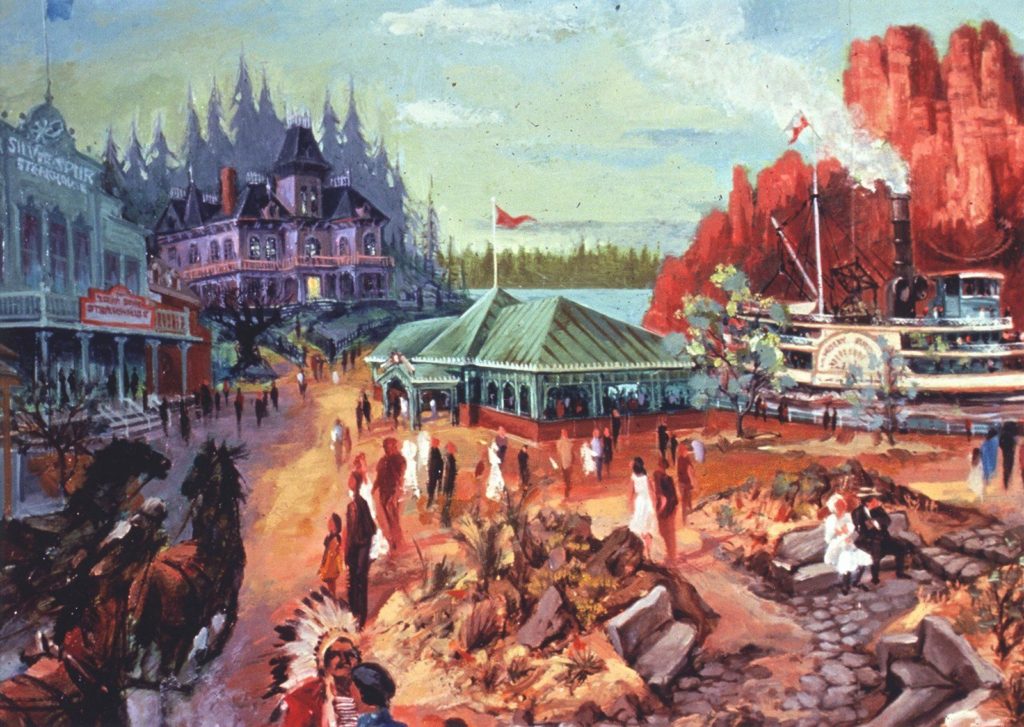
That’s why we’ve selected it as one of Park Lore’s Modern Marvels, joining our in-the-details look at such industry-shattering attractions as The Amazing Adventures of Spider-Man, Mystic Manor, Journey to the Center of the Earth, and Revenge of the Mummy… Today, we’ll dive into the hallowed history of Disney’s Haunted Mansion and how it morphed into the dark, romantic, operatic Phantom Manor… and examine the changes Disney made in 2019 that – depending on whom you ask – either fixed the faults of Phantom Manor, or made it a twisted telling of the tale you won’t believe.
And before we head off, remember that you can unlock rare concept art and audio streams in this story, access over 100 Extra Features, and recieve an annual Membership card and postcard art set in the mail by supporting this clickbait-free, in-depth, ad-free theme park storytelling site for as little as $2 / month! Become a Park Lore Member to join the story! Until then, let’s start at the beginning…
History in the dark
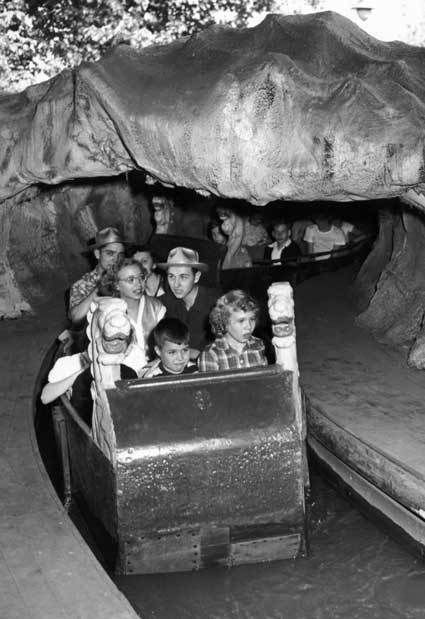
As frequent readers of our in-depth entries will know, the story always begins years before an attraction even opens. In this case, we can start a century earlier.
While we may not often think of their earliest installations, dark rides have been around for more than a hundred years. As far back as the late 1800s, early amusement parks constructed simple water channels kept flowing by waterwheels, passing through “Old Mills” or “River Caves” – dimly-lit by the brand new electric lightbulb. (The darkened, slow-moving nature of these rudimentary rides also earned them another name – “Tunnels of Love” – for their concealed opportunity to canoodle in the prudish Victorian era.)
As the years pressed on, the scenes (and sometimes scares) of these dark rides became more elaborate, resulting in spook houses, ghost trains, Noah’s Arks, mine rides, and laff-in-the-dark funhouses powered by boat, by cart, or by foot.
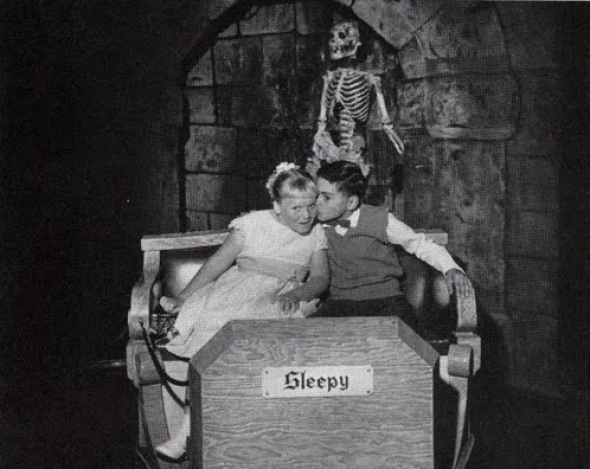
For most Imagineering fans, however, the timeline of the dark ride resets in 1955, when Disneyland opened with three auspicious attractions as the centerpiece of its Fantasyland: Snow White and Her Adventures, Mr. Toad’s Wild Ride, and Peter Pan’s Flight.
Those early Disney dark rides were relatively simple – each with a ride systems manufactured and installed by Arrow Development, complete with off-the-shelf ride vehicles merely reclad in themed fiberglass and steel shells, traveling through painted plywood scenes set aglow with ultraviolet light. But in their simplicity, these opening day dark rides still set the standard for what a “classic” Disney dark ride would look like.
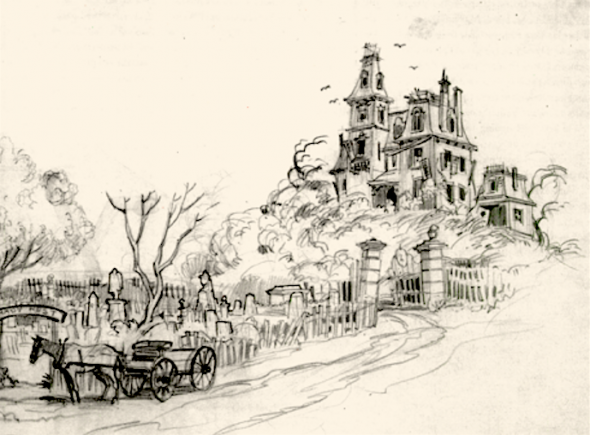
And even there in Disneyland’s early days, Walt and company had considered the idea of a haunted house walkthrough dark ride. As a matter of fact, Disney Legends Harper Goff and Ken Anderson had sketched out initial plans that predate the park’s opening. Fittingly, the haunted house they envisioned would’ve been a ramshackle Queen Anne style home, ominously perched on a hillside just outside of Main Street, U.S.A. Brilliantly, that would narratively cast the home as the universally-recognized trope of “the creepy old house in town;” arguably an existential urban legend all small town guests would recognize.
Though that haunted house never came to be, before the park’s tenth anniversary a very different kind of abandoned manor appeared elsewhere…
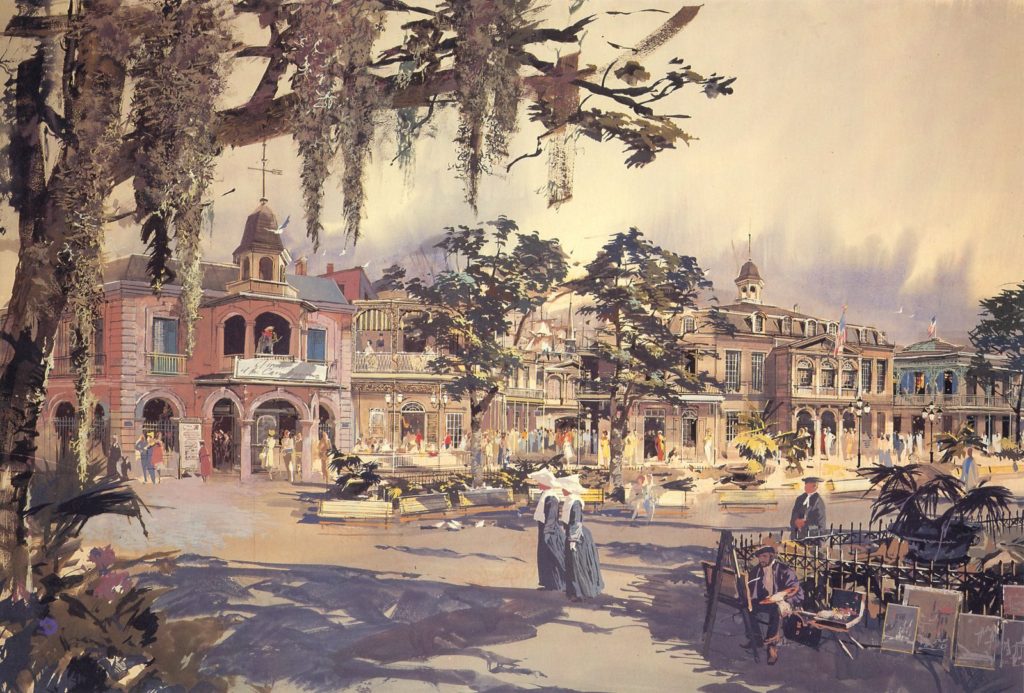
As luck would have it, Walt’s own fascination with Dixieland music and a series of successful bandstand and riverboat events in Frontierland had convinced him to expand Disneyland’s Frontierland by telling more stories of America’s Western growth and culture. It was in the late ’50s that designers first got to work on developing a new neighborhood along the park’s Rivers of America – what would become New Orleans Square. To Walt’s thinking, its two headlining attractions would be a walk-through wax museum of pirate scenes, and the long-forgotten haunted house.
So there, on the outskirts of the meticulously designed French Quarter, concealed behind a wrought-iron gate, a towering, stately, white plantation house appeared.
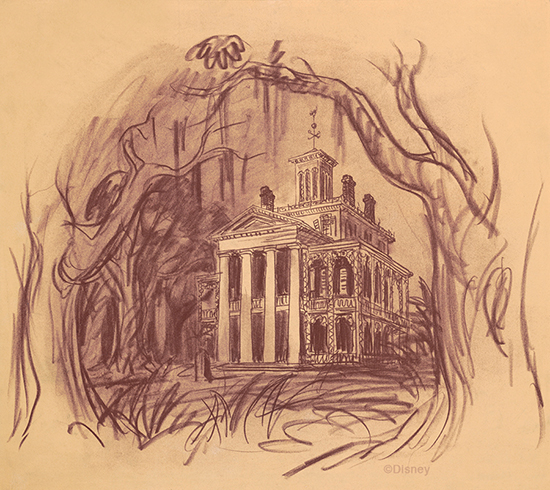
Designers initially planned to “age” the house with shattered windows, tattered curtains, mossy siding, and overgrown gardens but Walt wouldn’t have it. Less than a decade out from Disneyland’s opening, Walt still felt that he had a lot to prove in differentiating his “theme park” from the ramshackle, run-down midway amuseuments in the era. A dilapidated, decaying home – even a haunted one – might detract from the pristine appearance of Disneyland.
So, looking to the fabled, stately, sprawling, and supernatural Winchester Mystery House in San Jose, California (a beautiful Queen Anne Style Victorian manor famous for its windows to nowhere, doors to dropoffs, and stairs that lead into solid ceilings) Walt decreed, “We’ll take care of the outside, and the ghosts will take care of the inside.”
Vacancy
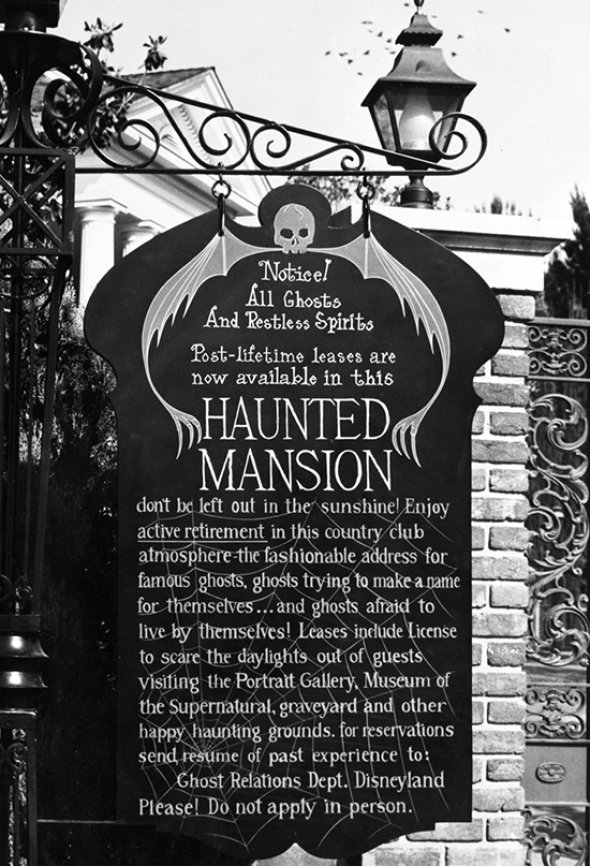
By 1963, the elegant, ivory, Southern mansion on the edge of Frontierland appeared ready to open. A sign posted against the gate announced the availability of “post-lifetime leases” for all ghosts and restless spirits in this new Haunted Mansion.
However, the manor’s gates remained locked through 1963.
And 1964.
And 1965.
Though the mansion had been built, the attached, hidden showbuilding hadn’t. That’s because Walt and the team hadn’t even settled on what the attraction inside would be when they were called East to the 1964 – 65 New York World’s Fair. And just think of how Disney’s portfolio had changed because of it. By 1965, Disney was dismantling the projects they’d developed for the Fair and was shipping them back to Disneyland for installation: Great Moments with Mr. Lincoln (with its unthinkable humanoid Audio-Animatronics figure), the Modern Marvel: Carousel of Progress, the technology behind the Lost Legend: The Peoplemover, and “it’s a small world” (with its groundbreaking, high-capacity boat-powered dark ride).

So the Haunted Mansion didn’t open in 1965.
Or 1966.
Then, that December, Walt Disney unexpectedly passed away from lung cancer. Across the company, projects stalled. The team Walt had left behind didn’t know how to (or even if) they should proceed on Walt’s pet projects without him. So as 1967 dawned, the beautiful white plantation house still sat empty. And worse, Walt had never explicitly decreed what he thought this Haunted Mansion should contain…
Haunting harmony

The story of the creation of the Haunted Mansion is one of the most interesting in Disney Parks history because it was the first major project tackled without Walt, and without a good grasp of what exactly he’d want. The reason the story picks back up in 1967 – after four years of the mansion façade sitting empty – is because of the opening of Walt’s post-mortem magnum opus: Pirates of the Caribbean.
Remember, Walt had initially planned for Pirates to be a walk-through wax museum, with small batches of guests lead through by individual Cast Members. But after developing the massively high-capacity ride system behind “it’s a small world” for the World’s Fair, it became obvious that there was a better way to efficiently move guests through scenes – a reinvention of the dark ride itself. Inevitably, the walkthrough imagined for a haunted house a decade ago was now impractical.
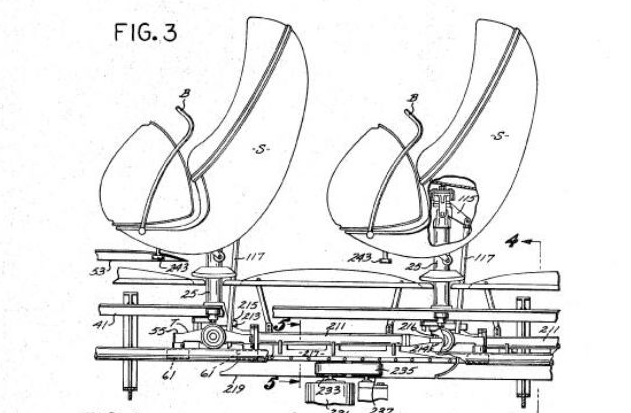
Instead, designers decided to re-use the groundbreaking, patented Omnimover ride technology (which we listed among our list of the Seven Modern Wonders of the Theme Park World) that had premiered in Tomorrowland 1967’s Lost Legend: Adventure Thru Inner Space. The clamshell-shaped Omnimover was a brilliant advance in both operations and storytelling given that the incredibly high capacity ride system was constantly moving, continuously loading, and could pivot or fully rotate along the ride’s course, giving designers the real-life power of a camera.
While the Omnimover was decided on and the Haunted Mansion was redeveloped from a walkthrough to a high-capacity ride-through, the design for the ride inside came down to two famously opposing viewpoints.
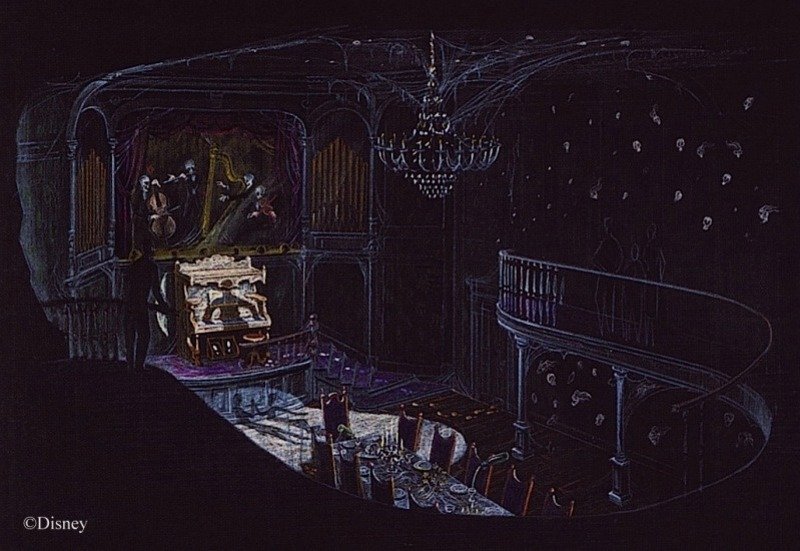
Claude Coats (the Disney Legend, background animator, and designer of Pirates of the Caribbean, Adventure Thru Inner Space, Mr. Toad’s Wild Ride, 20,000 Leagues Under the Sea, and Horizons) believed the Haunted Mansion should be an atmospheric, spooky tour past endless hallways, cryptic vignettes, unexplainable special effects, and frightening, characterless environments – “scary sights and sounds.”
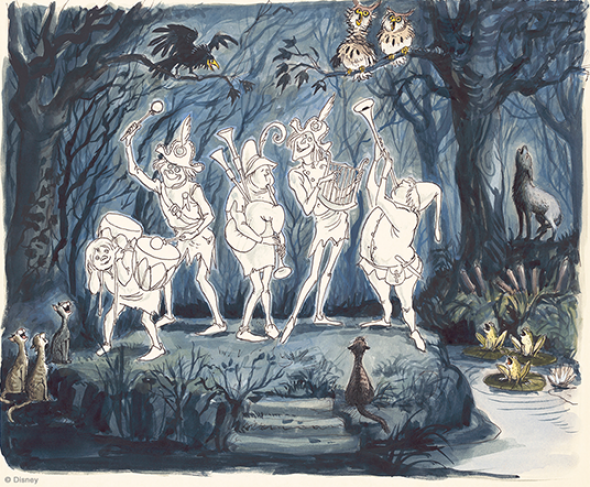
Marc Davis (designer of the Jungle Cruise, The Enchanted Tiki Room, “it’s a small world,” Carousel of Progress, Country Bear Jamboree, World of Motion, and Magic Kingdom’s fabled never-built Western River Expedition) instead believed that this Haunted Mansion should be a “frightfully funny” tour packed with whimsical, iconic characters, zany dark ride gags, humorous vignettes, and songs.
And without Walt to cast the tie-breaking ballot, it came to X Atencio (who wrote the script for Adventure Thru Inner Space, Pirates of the Caribbean, and the Haunted Mansion, as well as the theme songs for the latter two – “Yo-Ho (A Pirate’s Life for Me)” and “Grim Grinning Ghosts”) to meet in the middle.
It’s no accident that the Haunted Mansion has an eerie, creepy, uninhabited, discordant introduction (think of the Stretching Room, the “limbo” boarding area, and the manor’s first halls) gradually transitioning at the seance and ballroom to include memorable characters, laughter, and song (like the Hatbox Ghost, the singing busts, and the Hitchiking Ghosts). In fact, it’s an unexpectedly harmonious balance that feels instantly timeless.
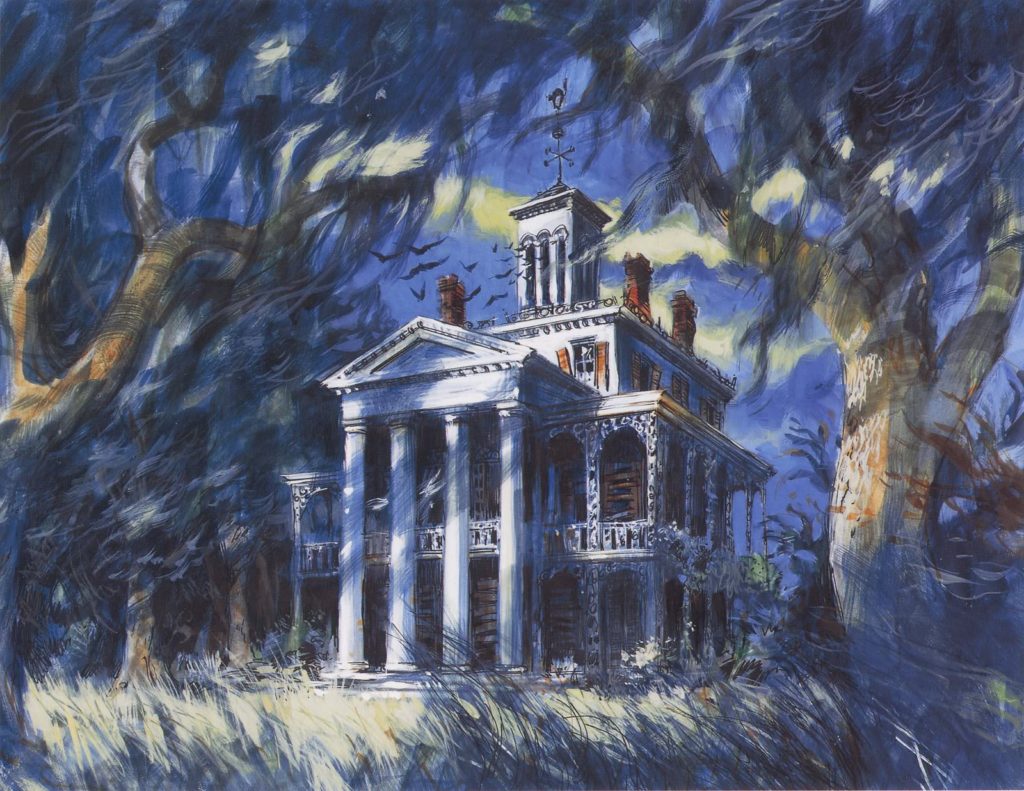
On the next page, we’ll dissect the story (or lack thereof?) told by the Haunted Mansion, watch as hauntings spread beyond Anaheim, and begin to piece together what led to Disneyland Paris’ ride being one-of-a-kind.


